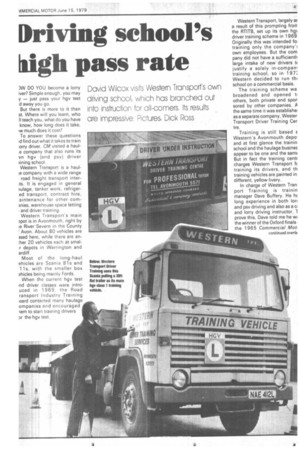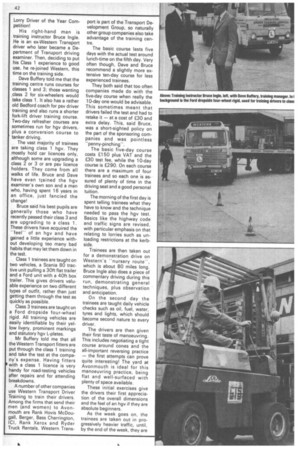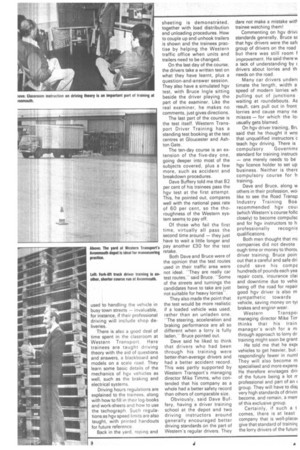Driving school'
Page 43

Page 44

Page 45

If you've noticed an error in this article please click here to report it so we can fix it.
kigh pass rate David Wilcox visits Western Transports own driving school; which has branched out into ins-ruction for all-corners. Its results are impressive Pictures, Dick Ross
)1A/ DO YOU become a lorry iver? Simple enough, you may y — just pass your hgv test d away you go.
But there is more to it than at. Where will you learn, who II teach you, what do you have know, how long does it take, iw much does it cost?
To answer these questions id find out what it takes to train orry driver. CM visited a haut
e company that also runs its vn hgv (and psv) driver )ining school.
Western Transport is a haulle company with a wide range road freight transport interits. It is engaged in general lulage, tanker work, refrigered transport, contract hire, aintenance for other commies, warehouse space letting and driver training.
Western Transport's main spot is in Avonmouth, right by le River Severn in the County F Avon. About 80 vehicles are ased here, while there are anther 20 vehicles each at smalldepots in Warrington and ardiff.
Most of the long-haul ehicles are Scania 81s and s, with the smaller box ehicles being mainly Fords. When the current hgv test nd driver classes were introuced in 1969, the Road ransport Industry Training ,oard contacted many haulage ompanies and encouraged lem to start training drivers Dr the hgv test. Western Transport, largely aE a result of this prompting frorr the RTITB, set up its own hg■ driver training scheme in 1969 Originally this was intended to training only the company't own employees. But the com pany did not have a sufficienth large intake of new' drivers tc justify a solely in-compan, training school, so in 197: Western decided to run tht school on a commercial basis.
The training scheme wa broadened and opened t■ others, both private and spor sored by other companies. A the same time it was establishel as a separate company, Wester Transport Driver Training Cer tre.
Training is still based E Western's Avonmouth depo. and at first glance the trainin school and the haulage busines appear to be one and the samf But in fact the training centr charges Western Transport fc training its drivers, and th training vehicles are painted in different, yellow livery.
In charge of Western Tran port Training is trainin manager Dave Buffery. He hE long experience in both Ion and psv driving and also as a
and lorry driving instructor. 1 prove this, Dave told me he wt the winner of the Oxford finals the 1 965 Commercial Mot
Lorry Driver of the Year Competition!
His right-hand man is training instructor Bruce Ingle. He is an ex-Western Transport driver who later became a Department of Transport driving examiner. Then, deciding to put his Class 1 experience to good use, he re-joined Western, this time on the training side.
Dave Buffery told me that the training centre runs courses for classes 1 and 3; those wanting ,class 2 for six-wheelers would take class 1. It also has a rather old Bedford coach for psv driver training and also runs a shorter fork-lift driver training course. Two-day refresher courses are sometimes run for hgv drivers,plus a conversion course to tanker driving.
The vast majority of trainees are taking class 1 hgv. They mostly hold car licences only, although some are upgrading a class 2 or 3 or are psv licence holders. They come from all walks of life. Bruce and Dave have even tcained the hgv examiner's own son and a man who, having spent 16 years in an office, just fancied the change!
Bruce said his best pupils are generally those who have recently passed their class 3 and are upgrading to a class 1. These drivers have acquired the "feel" of an hgv and have gained a little experience without developing too many bad habits that may let them down in the test.
Class 1 trainees are taught on two vehicles, a Scania 80 tractive unit pulling a 30ft flat trailer and a Ford unit with a 40ft box trailer. This gives drivers valuable experience on two different types of outfit, rather than just getting them through the test as quickly as possible.
Class 3 trainees are taught on a Ford dropside four-wheel rigid. All training vehicles are easily identifiable by their yellow livery, prominent markings and statutory hgv L-plates.
Mr Buffery told me that all the Western Transport fitters are put through the class 1 training
and take the test at the company's expense. Having fitters
with a class 1 licence is very handy for road-testing vehicles after repairs and for attending breakdowns.
A number of other companies use Western Transport Driver Training to train their drivers. Among the firms that send their men (and women) to Avonmouth are Rank Hovis McDougall, Berger, Bass Charrington, ICI, Rank Xerox and Ryder Truck Rentals. Western Trans port is part of the Transport Development Group, so naturally other group companies also take advantage of the training centre.
The basic course lasts five days with the actual test around lunch-time on the fifth day. Very often though, Dave and Bruce recommend a slightly more extensive ten-day course for less experienced trainees.
They both said that too often companies made do with the five-day course when really the 10-day one would be advisable. This sometimes meant that drivers failed the test and had to retake it — at a cost of £30 and extra delay. This, said Bruce, was a short-sighted policy on the part of the sponsoring companies and was pointless "penny-pinching".
The basic five-day course costs £150 plus VAT and the £30 test fee, while the 10-day course is £290. On each course there are a maximum of four trainees and so each one is assured of plenty of time in the driving seat and a good personal tuition.
The morning of the first day is spent telling trainees what they have to know and the technique needed to pass the hgv test. Basics like the highway code and traffic signs are revised, with particular emphasis on that relating to lorries such as unloading restrictions at the kerbside.
Trainees are then taken out for a demonstration drive on Western's "nursery route", which is about 80 miles long. Bruce Ingle also does a piece of commentary driving during this run, demonstrating general techniques, plus observation and anticipation.
On the second day the trainees are taught daily vehicle checks such as oil, fuel, water, tyres and lights, which should become second nature to every driver.
The drivers are then given their first taste of manoeuvring. This includes negotiating a tight course around cones and the all-important reversing practice — the first attempts can prove quite interesting! The yard at Avonmouth is ideal for this manoeuvring practice, being flat and well-surfaced with plenty of space available.
These initial exercises give the drivers their first appreciation of the overall dimensions and the feel of an hgv if they are absolute beginners.
As the week goes on, the trainees are taken out in progressively heavier traffic, until, by the end of the week, they are used to handling the vehicle in busy town streets — invaluable, for instance, if their professional driving will include shop deliveries.
There is also a good deal of time spent in the classroom at Western Transport. Here trainees are taught driving theory with the aid of questions and answers, a blackboard and models on a scale road. They learn some basic details of the mechanics of hgv vehicles as well, such as the braking and electrical systems.
Driving hours regulations are explained to the trainees, along with how to fill in their log-books and work-sheets and how to use the tachograph. Such regulations as hgv speed limits are also taught, with printed handouts for future reference.
Back in the yard. roping and sheeting is demonstrated, together with load distribution and unloading procedures. How to couple up and unhook trailers is shown and the trainees practise by helping the Western traffic office when units and trailers need to be changed.
On the last day of the course, the drivers take a written test on what they have learnt, plus a question-and-answer session. They also have a simulated hgv test, with Bruce Ingle sitting beside the driver playing the part of the examiner. Like the real examiner, he makes no comments, just gives directions.
The last part of the course is the test itself. Western Transport Driver Training has a standing test booking at the test centres at Gloucester and Ashton Gate.
The ten-day course is an extension of the five-day one, going deeper into most of the subjects covered, plus a few more, such as accident and breakdown procedures.
Dave Buffery told me that 82 per cent of his trainees pass the hgv test at the first attempt. This, he pointed out, compares well with the national pass rate of 60 per cent, so the thoroughness of the Western system seems to pay off.
Of those who fail the first time, virtually all pass the second time around — they just have to wait a little longer and pay another £30 for the test retake.
Both Dave and Bruce were of the opinion that the test routes used in their traffic area were not ideal. "They are really car test routes," said Bruce. "Some of the streets and turnings the candidates have to take are just not suitable for heavy lorries".
They also made the point that the test would be more realistic if a loaded vehicle was used, rather than an unladen one. "The steering, acceleration and braking performance are all so different when a lorry is fully laden," Bruce pointed out.
Dave said he liked to think that drivers who had been through his training were better-than-average drivers and had a better accident record. This was partly supported by Western Transport's managing director Mike Timms, who contended that his company as a whole had a better safety record than others of comparable size.
Obviously, said Dave Buffery, having a driver training school at the depot and two driving instructors around generally encouraged better driving standards on the part of Western's regular drivers. They dare not make a mistake with trainee watching them!
Commenting on hgv drivi standards generally, Bruce SE that hgv drivers were the saf( group of drivers on the road but there was still room f improvement. He said there a lack of understanding by drivers about lorries and th needs on the road.
Many car drivers under( timate the length, width a speed of modern lorries wh pulling out of junctions waiting at roundabouts. As result, cars pull out in front lorries and cause many ne misses — for which the 101 usually gets blamed.
On hgv driver training, BrL said that he thought it wro that unqualified instructors c teach hgv driving. There is compulsory GovernmE standard for training instruct' — one merely needs to be hgv licence holder to set up business. Neither is therE compulsory course for h training.
Dave and Bruce, along w others in their profession, wol like to see the Road Transp Industry Training Boa recommended hgv coui (which Western's course folio closely) to become compulsc and for hgv instructors to h professionally recognis qualifications.
Both men thought that ME companies did not devote ough time or money to thorot driver training. Bruce poin out that a careful and safe dri could save his compz hundreds of pounds each yea repair costs, insurance clai and downtime due to vehic being off the road for repair good hgv driver is also m sympathetic towards vehicle, saving money on tyi brakes and engine wear.
Western Transpol managing director Mike Tirr thinks that his train manager's wish for a m through approach to lorry dr training might soon be grant He told me that he expi vehicles to get heavier, but respondingly fewer in numl They will also become m specialised and more expens He therefore envisages dril of the future being a lot rr professional and part of an group. They will have to disi very high standards of drivin become, and remain, a merr of this exclusive group.
Certainly, if such a t comes, there is at least company that is well-placel give that standard of traininc the lorry drivers of the futurE




























































































































